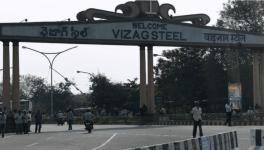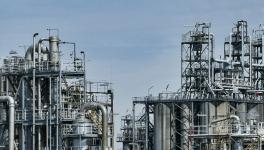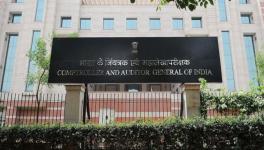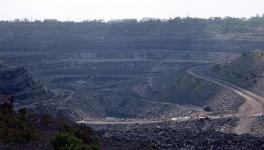The Reliance KG Gas Scam
The CAG Draft Report on the audit of the Production Sharing Contracts for the on-shore and off-shore oil and gas blocks is now widely being circulated in the media, showing once again the unholy nexus between the UPA and big capital in the country.
The CAG has shown that the Directorate General of Hydrocarbons (DGH) allowed Reliance Industries and other private operators to gold-plate the capital costs of the plant allowing them to make huge profits. The Production Sharing Contract pegged the profit share of the private operators and the Government to something called an Investment Multiplier, which meant that higher the capital cost, the larger the share of the profits of the private parties.
The capital costs in the KG Basin D-6 Block went up from $2.4 billion in the initial contract to $8.5 billion. This was the pattern followed in other gas and oil fields also, involving Reliance, Cairn Energy and others. In all this, the modus operandi was to submit a bid which shows a certain capital cost and during the operation of the contract, inflate the capital cost by a huge amount with the connivance of DGH and the Ministry of Petroleum. The Management Committee in which the Government had 2 nominees out of 4 played no oversight role in such inflation of contracts.
For inflating the capital costs, the familiar route is of course over-invoice through sweetheart deals from “friendly” sub-contractors, sometimes even a Reliance family company. While the CAG has not computed the loss to the exchequer, it has held that the Government has suffered large losses on this account. It has also held that the Production Sharing Contact being followed by the Government of India has very little controls on the investment costs, unlike for example, Bangladesh, where the Management Committee which has 50% Government nominees as in India, has to approve any expenditure above $500,000.
The CAG Draft Report has also brought out that while the contract envisaged that if the company did not develop certain areas within the contracted area within the stipulated time, it should have been relinquished. Instead, the DGH and the Ministry of Petroleum allowed the whole area to be designated as “discovery area” in violation of the contract.
As we shall show below, there are two sets of scams that have taken place, CAG having looked at only one of them. One is of course various violations of the Production Sharing Contract as pointed out by CAG; the second is the high price of Reliance gas -- $4.2 per Million BTU (MBTU) -- set in 2007 by the Empowered Group of Ministers headed by Pranab Mukherjee. Reliance itself admitted in the Court case between it and NTPC/Anil Ambani Group that its production cost was $1.43 per MBTU. Reliance Industries Ltd. (RIL) had initially agreed to supply gas at $2.34 to both NTPC and Anil Ambani Group, which it subsequently reneged once the EGOM set the price at $4.2. It might be noted that by its own calculations, RIL would have made profits of 50% if it had supplied gas at $2.34.
Gold-plating Capital Costs in KG D6 Block and the role of DGH
The Gas and oil field in question is known as KG-DWN-98/3 (Block D-6), and consists of 8,100 sq. Km. of off-shore area in the Krishna Godavari basin. Block D-6 was awarded to Reliance Industries (90%)and Niko Resources Ltd (10%) under New Exploration Licensing Policy 1 (NELP-1) bidding round under a Production Sharing Contract. Initially, the D6 was to produce 40 million MMSCD (Million Cubic meters per day), which was subsequently revised to 80 MMSCD. The initial development cost in the contract was $2.4 billion which was revised through an “addendum” in 2006 to $5.2 billion in the first phase and $3.3 billion in the second phase. CAG has also observed that the $3.3 billion for the second phase has every possibility of being hiked up in the same way as the first phase.
The Production Sharing Contract (PSC) that the Government had struck with RIL in 2000 envisaged that there would be something called “cost petroleum”, which would cover Government royalty of 5%, operating costs, the costs of exploration, and the development cost of producing gas. Till the the capital costs are recovered, 90% of the petroleum/gas sold would be considered as “cost” petroleum and the rest 10% would be “profit” petroleum.
The catch here is that proportion of profit sharing changes depending on the amount of cost recovered to the total cost, something that the contract calls as Investment Multiplier. The proportion of shares between RIL and Government is pegged to this Investment Multiplier. Till the major portion of the costs are recovered, Reliance gets the major share of the “profit” petroleum. It is only after the major part of the costs have been recovered that the Investment Multiplier begins to increase and so does Government's share, which is pegged to this Investment Multiplier. That is why increasing capital costs helps Reliance retain a much larger share of the profits in the initial years, while the Government gets its share only in the last phase, when the production starts to decline.
Reliance therefore can make a double killing -- by over invoicing the capital costs, it can skim money from the top. In addition, by ensuring that the capital costs take a longer time to recover, it takes out its major share of the profit right in the beginning.
If it was only a question of getting money later, it could be argued that Government has not suffered a loss, only postponed its earnings. But here is the problem. In financial accounting, money earned later has to be discounted by an amount equivalent to what we would have earned if we had put the money in the bank and earned interest. The same amount earned today therefore is more valuable than money earned one or more years later. If we apply the standard discounted cash flow method – discount future earnings by a nominal discounting rate of 10% – we find (see table below) that Government's share would have been 63% of the total profits if the original figures of production and and capital costs retained, while now it is only 48%. Conversely, Reliance's share goes up from 37% to 52%.
|
|
Capital Costs $ Billion |
Production Volume MMSCMD |
Total Profits $ Billion |
RIL's Share % |
Gov's Share % |
Discounted RIL Share % |
Discounted Govt's Share % |
|
Original |
2.5 |
40 |
19.4 |
30 |
70 |
37 |
63 |
|
Revised |
8.8 |
80 |
35.4 |
44 |
56 |
52 |
48 |
Notes:
-
Calculations done by the author
-
Figures based on a 12 year production period and constant gas production.
-
If a 16 year period is taken and/or production figures increased, the figures would change somewhat, but the broad trends would remain the same.
If we look at the fact that the extra investments have doubled production, how much has each of the parties gained out of this doubling of revenue? Out of the extra revenue (at discounted prices) of about $7.5 billion, Reliance gains about $5.5 billion and the Government only about $ 2 billion.
The increase of four times the capital cost for a mere doubling of production had always seemed highly suspicious. No logic can explain why doubling of capacity to should lead to such an increase – economies of scale normally ensures that a doubling of capacity would increase capital cost by about one and half times. The Draft CAG Report now makes clear that the increase from $2.4 billion to $5.2 billion took place for the first phase, where no augmentation of capacity was involved. This makes nonsense of the bidding procedure for awarding of blocks, as the calculations for award of blocks involves profit shares promised by the various parties. If the capital costs change, all this change, vitiating the award of contract itself.
Not only did the Directorate General of Hydrocarbons accept this increase in capital cost, which under the contract it need not have accepted, it did so in unseemly haste – it took a scant 53 days to go through cost increase of nearly $ 6.3 billion! Some wizardry indeed.
The CAG's Draft Report brings out the various ways costs could have been doctored – single party bids, making changes to scope, substantial variation on orders, etc. CAG has stated that it is going to examine these issues in greater detail in a subsequent audit.
In November 2009, preliminary investigations by the CBI had found evidence of “gross abuse and misuse of public office” by V K Sibal, the then Director General of DGH. This had been informed to the Petroleum Ministry and to CVC. Numerous links had been found between Sibal and Reliance. The CBI enquiry remains stalled, very much in the telecom 2G mode, showing that Reliance tentacles in the Government go far beyond Sibal.
The Curious Case of $4.2 Gas Price
An Empowered group of Ministers (EGoM), in September 2007, set the price of gas at $4.2 per MBTU for five years with no transparency and without giving any reason for this price. It might be noted that in the same period, (2005-2008), ONGC was being paid only $1.8 per MBTU. The $4,2 price was supposedly done on the basis of RIL's price “discovery.”
Reliance's price discovery was to ask a selected set of bidders to quote a gas price according to a formulae which fixed the price within a narrow range of $4.54 to $4.75. With this as the basis, Reliance declared the “discovered” price to be 4.59/MMBtu which was later revised to $4.3/MMBtu. The Government then magnanimously decided that the right price was $4.2 and claimed that it was arrived at through “a discovery” mechanism.
It might be argued that the Government also gained out of the high price of gas. This is indeed true – by our calculations, the Government stood to gain about $4 billion or about Rs. 20,000 crore from the increased price of gas as its share of profits. However, as gas is the major feedstock for fertiliser production and also a fuel for power, this gain has to be balanced against the resulting higher fertiliser and power prices. If the cost of production of fertiliser and power goes up, so does the government subsidy. So while the RIL would pocket the benefit of the higher cost of gas, the Government would have to pay out a much higher subsidy of around Rs. 75,000 crore for a gain of Rs. 20,000 crore and therefore incur a net loss of more than Rs. 55,000 crore.
It is indeed strange that at a time that the government complains about high cost of subsidies, it should itself promote policies that help private parties while pushing up its own subsidy bill.
Not only was the price set at a much higher level than the cost of production, it was also set in foreign exchange and pegged to the price of crude in the international market. Why should the gas price be set in dollars for even the future when the costs have already been incurred and therefore can easily be converted into rupees? Why should the gas price be set at $4.2 when RIL itself admitted in the court proceedings between it and Anil Ambani's RRNL/NTPC that its cost price of gas was $1.43 and it was willing in 2004 to sell NTPC gas at $ 2.34? What is the justification of pegging the domestic gas price to the price of crude in the international market, to which it has no relation?
Fixing gas prices without examining cost figures and a mechanism of converting the cost figures to a gas price is making gas pricing another way of handing out private largesse. No basis of the gas price rate of $4.2 has been given, so how did the Ministers pull this figure of $4.2 – straight out of their collective hat?
Promoting RIL's Monopoly in Gas
The last issue is one of monopoly. At the moment, Reliance is major gas producer, Reliance Gas Transportation and Infrastructure Limited (RGTIL) owns the pipeline and again Reliance is getting orders for citywide distribution of gas. Unlike the electricity sector, the Government does not have a problem in gas sector with a vertical monopoly of the type that Reliance is building. Originally, there was a proposal of a national gas grid, which would have GAIL as the nodal agency. This also makes economic sense as whoever owns the gas grid effectively dictates to both the producers as well as the consumers. That is why generally such facilities are independently run, with the state playing a crucial role. Unfortunately, all such policies in the country come a cropper when Reliance is in the picture. So also with the original gas grid. If we have a gas grid now, it will largely be a Reliance grid, with GAIL and others playing second fiddle.
We are already seeing the effect of this monopoly, with Government owned GAIL becoming a junior partner to Reliance and the transportation cost of $1.25 being charged by Reliance, over and above the $4.2 and again without any regulatory oversight.
CAG has made clear that the form of Production Sharing Contract under the NELP is deeply flawed in favour of the private operators. It provides a perverse incentive to increase capital costs to the detriment of Government's share of revenue. This is a policy issue that needs to be urgently addressed in view of the large number of blocks that have been handed out under NELP.
What does all this mean for the Indian people? Simply put, we are facing a double loot. On one hand, scarce national resources are being given away at a pittance. Gas and coal resources are being handed over to Amabanis, Tatas and sundry others at throw away prices. However, this is not helping the consumers, who are being asked to pay international oil and gas prices. Private loot of public resources coupled with public loot of the consumers – this is the essence of our petroleum policies.
It is indeed welcome that CAG has drawn attention to the problems in the Production Sharing Contract under the New Exploration Policy of the Government. However, it is important that other issues also be addressed, a key one being the pricing of gas. As for the CBI enquiry against officials who have connived with Reliance, hopefully public pressure will force a reluctant UPA to act. The only question is will Reliance be also put on the dock for having subverted the government machinery and having secured these huge windfalls?
Photograph Courtesy: fotopedia
Get the latest reports & analysis with people's perspective on Protests, movements & deep analytical videos, discussions of the current affairs in your Telegram app. Subscribe to NewsClick's Telegram channel & get Real-Time updates on stories, as they get published on our website.
























